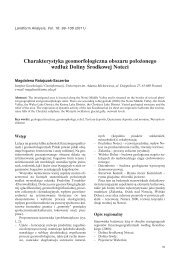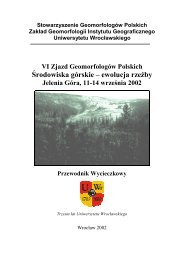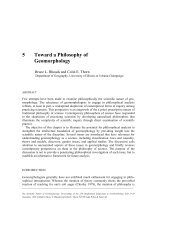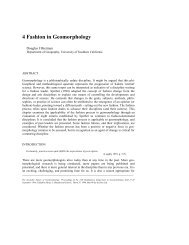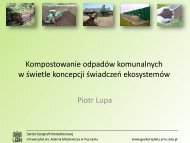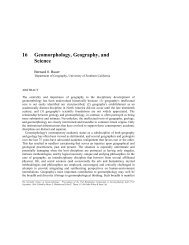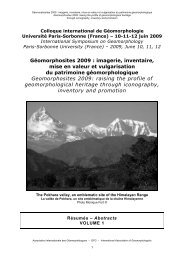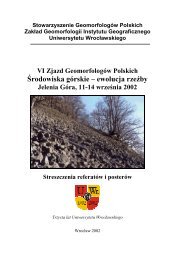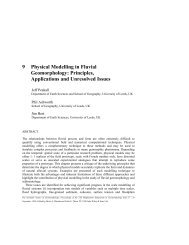Chapter 16 - Geomorphology, Geography, and Science Bernard 0
Chapter 16 - Geomorphology, Geography, and Science Bernard 0
Chapter 16 - Geomorphology, Geography, and Science Bernard 0
You also want an ePaper? Increase the reach of your titles
YUMPU automatically turns print PDFs into web optimized ePapers that Google loves.
GEOMORPHOLOGY, GEOGRAPHY, AND SCIENCE 385<br />
assertions have been made in pragmatic attempts to seek expedient solutions to<br />
interdisciplinary tensions. Douglas W. Johnson, for example, suggested that,<br />
geomorphology itself has suffered, <strong>and</strong> will continue to suffer, from attempts to include it in<br />
the geographic realm. In the history of its development, in its methods, <strong>and</strong> in its affiliations it<br />
is a part of geology (Johnson 1929, p. 211).<br />
However, this statement was made in the context of Johnson's 1928 presidential address to<br />
the Association of American Geographers through which he was engaging, by necessity,<br />
in a disciplinary-wide debate about the circumscription <strong>and</strong> future of an academically<br />
distinct geography. More recently, Worsley (1979) argued for the pragmatic separation of<br />
geomorphology from geography <strong>and</strong> suggested that its placement into any of several<br />
geosciences would enhance its utility to society largely because there would be access to<br />
better facilities, equipment, well-trained students, <strong>and</strong> geoscientific respectability. On<br />
intellectual grounds, such assertions are difficult to defend, <strong>and</strong> bold statements about<br />
geomorphology's detachment from geography are often followed by convoluted <strong>and</strong><br />
hidden references to the contrary. Duty (1983, p. 92), for example, suggests that 'if<br />
geomorphology should have been located within a single discipline, that discipline should<br />
have been geology'. But, he also notes that<br />
the question of where geomorphology belongs ... is badly structured. Formally, it belongs<br />
where practitioners are attached for payroll purposes. Functionally, it belongs on the<br />
surface/subsurface interface (Dury 1972, p. 201).<br />
Tinkler (1985) states quite emphatically that '... geomorphology is indisputably a part of<br />
geology ...' (p. xii), but then goes on to: (1) acknowledge the existence of institutional<br />
affiliations <strong>and</strong> academic connections between geomorphology <strong>and</strong> geography (p. xiv) <strong>and</strong><br />
other cognate disciplines (p. 5); <strong>and</strong> (2) admit that 'processes of the atmosphere acting on<br />
the earth's surface over both the short term <strong>and</strong> the long term provide the essential<br />
catalysts that mediate the geomorphic system' (p. 5), <strong>and</strong> that an 'intimate relation exists<br />
between geomorphology <strong>and</strong> vegetation, with soil <strong>and</strong> climate as important mediating<br />
agents' (p. 5). Even William Morris Davis, while speaking before the Geological Society<br />
of America, professed that 'all geography belongs under geology, since geography is<br />
neither more nor less than the geology of today' (Davis 1912, p. 121). Davis's statement<br />
seems paradoxical unless one appreciates that: (1) Davis's intellectual allegiances to<br />
geography <strong>and</strong> geology were united; (2) geography had not yet established itself as a fullfledged<br />
academic discipline in North America; <strong>and</strong> (3) Davis's views about the nature of<br />
geographical inquiry were largely restricted to physiography but were rapidly evolving<br />
with the discipline itself (see Johnson 1929, p. 209, footnote 12). It is to these generally<br />
interrelated conditions of geography, geology, <strong>and</strong> geomorphology that I now turn my<br />
attention.<br />
The relationship between geology <strong>and</strong> geomorphology is admittedly very intimate.<br />
During the eighteenth <strong>and</strong> nineteenth centuries, the dominant concern of geology, both as<br />
an intellectual pursuit <strong>and</strong> an academic enterprise, was underst<strong>and</strong>ing the character <strong>and</strong><br />
evolution of earth's surface (Chorley et al. 1964; Davies 1969; Tinkler 1985). It is<br />
noteworthy that the term 'geomorphology' is traceable only as far back as the mid-1800s<br />
(Tinker 1985, p. 4), suggesting that there was no practical need to separate the essence of



